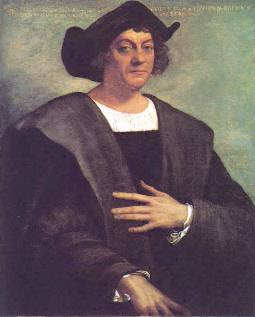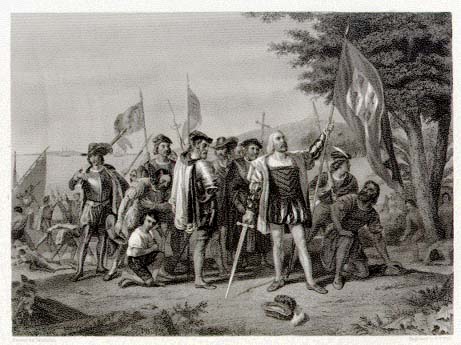|
|
The Landing of Christopher Columbus 1492 - The Discovery of America


Christopher Columbus - Discoverer Everyone recognizes that many people were in America long before Christopher Columbus. The Asiatic peoples who became Native Americans were certainly the first, tens of thousands of years ago. Also Norse expeditions to North America, starting with Bjarni Herjolfsson in 986, are well established historically. Many other pre-Columbian discoveries are not well established: claims have been made for St. Brendan, Basque fishermen, Portuguese, Chinese, Japanese, and even Carthaginians. Some of these claims may be true; most are probably not.
In spite of this, Columbus's discovery (or re-discovery, if you prefer) is rightly regarded as the most historically important, and will continue to be. That is because, unlike the others, Columbus inaugurated permanent large-scale two-way commerce between the Old World and the New. Previous discoveries were so little known that even the best educated Europeans were unaware of the existence of America prior to Columbus. The "Admiral of the Ocean Sea," unlike any of his predecessors, changed the world.
Christopher Columbus was born in 1451, northwest of the island, 200km from Ajaccio. He was the oldest of five children. As a child, he helped his father as a weaver. He always liked the sea. Genoa was an important seaport. There is no doubt that as a child he caught rides on ships. He had little schooling but was a genius with the sea. His plan was not to prove that the world was flat, but it was to find a shortcut to the Spice Islands. He wanted to establish a city there for trade, seaports, and much more. When he grew into a man he was interested in sailing to Asia by going west. First he went to the king of Italy and presented his idea before him. Italy wasn't looking for a way to Asia, they were still receiving riches from their old trade routes. His three ships were the Santa Maria, the Nina, and the Pinta.
Important Facts About Christopher Columbus -
- In 1492, he left Spain for his first voyage. He landed in San Salvador at Cap-Haitien and returned home to Palos, Spain, in 1493.
- In 1493, he left Spain for his second voyage. He landed on Marie-Galante, then went again in Cap-Haitien, St. Ann's Bay, and returned to Cadiz, Spain, in 1496.
- In 1498, he left Spain for his third voyage. He landed in Santo Domingo, and returned home again to Cadiz, Spain in 1500.
- In 1502, he left Spain for his fourth and final voyage. He landed on the Bay Islands off of Central America, Portobelo, and then returned home to Sanlucar, Spain, for the final time.
- He later died in 1506.

Man and Myth
After five centuries, Columbus remains a mysterious and controversial figure who has been variously described as one of the greatest mariners in history, a visionary genius, a mystic, a national hero, a failed administrator, a naive entrepreneur, and a ruthless and greedy imperialist.
Columbus's enterprise to find a westward route to Asia grew out of the practical experience of a long and varied maritime career, as well as out of his considerable reading in geographical and theological literature. He settled for a time in Portugal, where he tried unsuccessfully to enlist support for his project, before moving to Spain. After many difficulties, through a combination of good luck and persuasiveness, he gained the support of the Catholic monarchs, Isabel and Fernando.
The widely published report of his voyage of 1492 made Columbus famous throughout Europe and secured for him the title of Admiral of the Ocean Sea and further royal patronage. Columbus, who never abandoned the belief that he had reached Asia, led three more expeditions to the Caribbean. But intrigue and his own administrative failings brought disappointment and political obscurity to his final years.
In Search and Defense of Privileges
Queen Isabel and King Fernando had agreed to Columbus's lavish demands if he succeeded on his first voyage: he would be knighted, appointed Admiral of the Ocean Sea, made the viceroy of any new lands, and awarded ten percent of any new wealth. By 1502, however, Columbus had every reason to fear for the security of his position. He had been charged with maladministration in the Indies.
The Library's vellum copy of the Book of Privileges is one of four that Columbus commissioned to record his agreements with the Spanish crown. It is unique in preserving an unofficial transcription of a Papal Bull of September 26, 1493 in which Pope Alexander VI extended Spain's rights to the New World.
Much concerned with social status, Columbus was granted a coat of arms in 1493. By 1502, he had added several new elements, such as an emerging continent next to islands and five golden anchors to represent the office of the Admiral of the Sea.
As a reward for his successful voyage of discovery, the Spanish sovereigns granted Columbus the right to bear arms. According to the blazon specified in letters patent dated May 20, 1493, Columbus was to bear in the first and the second quarters the royal charges of Castile and Leon -- the castle and the lion -- but with different tinctures or colors. In the third quarter would be islands in a wavy sea, and in the fourth, the customary arms of his family.
 The earliest graphic representation of Columbus's arms is found in his Book of Privileges and shows the significant modifications Columbus ordered by his own authority. In addition to the royal charges that were authorized in the top quarters, Columbus adopted the royal colors as well, added a continent among the islands in the third quarter, and for the fourth quarter borrowed five anchors in fess from the blazon of the Admiral of Castille. Columbus's bold usurpation of the royal arms, as well as his choice of additional symbols, help to define his personality and his sense of the significance of his service to the Spanish monarchs. The earliest graphic representation of Columbus's arms is found in his Book of Privileges and shows the significant modifications Columbus ordered by his own authority. In addition to the royal charges that were authorized in the top quarters, Columbus adopted the royal colors as well, added a continent among the islands in the third quarter, and for the fourth quarter borrowed five anchors in fess from the blazon of the Admiral of Castille. Columbus's bold usurpation of the royal arms, as well as his choice of additional symbols, help to define his personality and his sense of the significance of his service to the Spanish monarchs.
The Book of Privileges is a collection of agreements between Columbus and the crowns of Spain prepared in Seville in 1502 before his 4th final voyage. The compilation of documents includes the 1497 confirmation of the rights to titles and profits granted to the Admiral by the 1492 contract of Santa Fe and augmented in 1493 and 1494, as well as routine instructions and authorizations related to his third voyage. We know that four copies of his Book of Privileges existed in 1502, three written on vellum and one on paper.
All three vellum copies have thirty-six documents in common, including the Papal Bull inter caetera of May 4, 1493, defining the line of demarcation of future Spanish and Portuguese explorations, and specifically acknowledging Columbus's contributions. The bull is the first document on vellum in the Library's copy and the thirty-sixth document in the Genoa and the Paris codices. The Library copy does not have the elaborate rubricated title page, the vividly colored Columbus coat of arms, or the authenticating notarial signatures contained in the other copies. The Library's copy, however, does have a unique transcription of the Papal Bull Dudum siquidem of September 26, 1493, extending the Spanish donation. The bull is folded and addressed to the Spanish sovereigns.
|
|
|
|
|
 Native American Nations
Native American Nations
